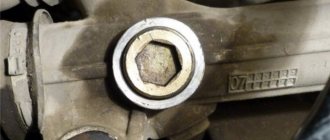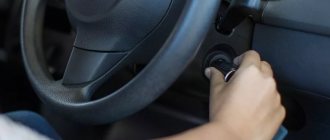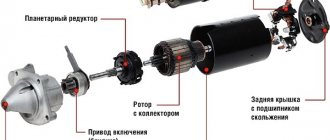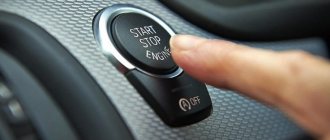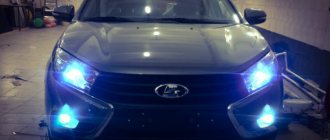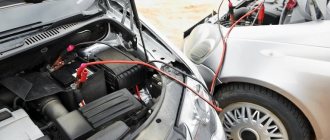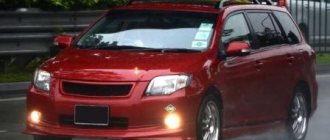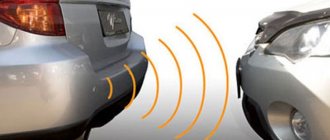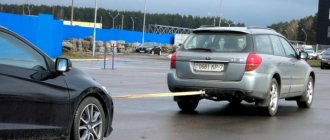During the operation of the car, quite often problems arise with starting the engine. In this case, often the engine itself and its systems are in perfect order, but the car cannot be started due to a discharged battery or problems with the starter.
In a situation like this, when the engine does not start, there are several options left:
- charge or change the battery;
- light a car;
- deliver the car to the repair site using a tow truck or on a “cord”;
- try to start it "from the pusher" and get there under your own power.
The last method is the fastest and easiest, but there are certain difficulties. You need to know how to properly start a car from a pushrod, what speed to accelerate the car to before starting, what gear to engage, whether it is even possible to start an automatic transmission from a pushrod, etc. Read more in our article.
Why push the car?
First, a little job description. The engine starts by turning the crankshaft.
On a working car, its movement (and the movement of other necessary parts) is initiated by the starter.
But sometimes, due to malfunctions, you can use the starter for hours without any benefit. Then towing comes to the rescue.
When the drive wheels move, even forcibly, the torque is supplied through the transmission to the shaft. This allows you to start the car.
The problem itself usually occurs due to a weak battery charge. If the battery produces excessively low current, the crankshaft will turn more slowly and harder.
When the charge is completely depleted, you can only hear the usual clicks. Both the starter and another ignition unit can break down.
Finally, if the device does not respond at all to turning the key, there is an open circuit or a fault with the contacts.
In all of the above cases, pushing the car is the only way to try to start it.
How to start a car from a pusher: description of the process and nuances
Starting a car from a pushrod is a lost art for many motorists today. But not so long ago, every self-respecting car owner knew how to start the engine without using a starter. Why was this necessary?
It’s just that earlier drivers could mainly rely only on themselves, their knowledge and skills. Often, you either had to wait too long for roadside assistance, or there was the option of not waiting for it at all. Let's say, on some remote roads in the north of our vast homeland (there were no mobile phones or they were just beginning to appear), how to call for help? We answer: there was no way to call, just to catch a ride and hope that a colleague in the steering wheel would not leave him in trouble...
But even in our advanced 21st century, with telephones and road services constantly at hand, providing towing and mobile repair services, it would be nice for motorists to know the secrets of starting the engine without the help of a starter. After all, situations on the road are different, and it’s better to have an alternative option than to rely on someone else’s virtue.
Conditions under which a car can be started from a pushrod
From the very beginning it is worth clarifying what kind of car we mean. So, to the question whether it is possible to start a car using a pusher, the answer will be negative.
More precisely, you can try to do this, and sometimes it will even work out well. However, the downside is that the transmission is almost guaranteed to be “killed”.
Such an act will be a way out of the situation only when “delay is like death.”
In all other situations, it is better not to guess whether the car can be started automatically from a pusher or not (especially since you will need a tow), but to use the services of a tow truck. This will be both easier and cheaper.
The next important point is to make sure that this does not create any interference or emergency situations. At the same time, even on the pushed vehicle itself, everything should be in order with the brakes and controls.
You can start a car manually using a pushrod with the help of 1-3 people. Much also depends on how easily the car starts on its own in normal mode.
The startup process may also be affected by:
- acceleration force;
- the skill of the drivers;
- engine's type;
- compression in pistons;
- motor temperature;
- condition of the driving part and tires;
- nature of the road.
Conditions for successful launch
The car engine is started by rotating the crankshaft with a starter powered by battery energy. If turning the key in the ignition switch results in silence or the sound of the starter working hard, it is recommended to stop trying so as not to completely drain the battery. The higher the charge level, the greater the chance of starting the engine.
To prevent pushing a car from turning into a grueling physical exercise and to produce results, consider the following points:
- It is unacceptable to start a car with an automatic transmission from a pusher and is fraught with expensive repairs.
- The number of assistants must correspond to the weight of the machine. If 2 people (including the driver) can push a small car, then an SUV or minibus requires 4–5 helpers.
- Before forcibly starting a car equipped with a carburetor power system and a mechanical fuel pump, be sure to pump up the fuel manually.
- Levers for manual pumping are also found on old diesel engines with a mechanical injection pump (stands for high pressure fuel pump). Use this handle to pre-pressurize the line.
- The injector and the new diesel engine, equipped with an electric pump, are very difficult to push and start “cold” if the battery charge is close to zero.
The last point requires clarification. For normal operation of diesel and injection nozzles, the electric fuel pump creates a certain pressure in the line. During long periods of machine inactivity, it gradually decreases. When the battery is completely dead, when the ignition is turned on, there is not enough energy to operate the pump, and the pressure in the system remains low. To lift it, you need to spin the generator, that is, you will have to push the car for a long time or drag it in tow. Sometimes it's easier to find a working battery .
The warning regarding cars with automatic transmission is not unfounded. It is useless to forcibly rotate the gearbox shafts from the wheel side - without oil pressure, the input shaft will not engage with the crankshaft. Unless you accelerate the car to a speed of 50 km/h and turn on the Drive mode, which will lead to instant failure of the friction discs. It is strictly not recommended to carry out such experiments - the launch is carried out exclusively from the battery.
How to properly start a car using a pushrod
To properly start a car with a manual pushrod, you should start by turning on the ignition.
If possible, you should move the car in the direction of a visually noticeable slope. It is important not to miss the moment of acceleration to 10-20 kilometers. Then squeeze the clutch and go into second gear.
Use the gas pedal as needed. After starting, the cars switch to neutral gear, if necessary, warm up the engine to operating temperature.
In winter, on snow, as well as on sand, gravel and regular dirt roads, it is better to engage not second, but 3rd gear. At second speed the wheels may slip.
Nuances for cars with injection engines
If the injection machine does not start with the starter, then it can also be started from the pusher, just like models with mechanics.
The injection engine can also be started from a pusher
The vehicle is first accelerated to a speed of 20 km/h, then 3rd gear is put in and the clutch is released. To prevent the engine from stalling, be sure to apply several presses of the accelerator.
Is it harmful to start a fuel-injected car from a pushrod, because it has a lot of complex electronics? Are the fears of the owners of such cars justified or not? Most likely, since the “manpower” starting method was still primarily used by our grandfathers and is more suitable for carburetor cars.
Usually, no problems arise with injection systems, but only if the actions are performed according to the instructions and consistently.
Before you start work, you should check the voltage in the electrical circuit and the battery (it tends to go low) - the readings should be within 12 V. If there are current surges in one direction, it is better to refuse and immediately call for help.
There are also several features of fuel-injected vehicles that need to be taken into account.
- Do not touch the gas until the engine reaches a sufficient number of revolutions. Electronics can fail if you press the accelerator with your entire foot. You need to work with this pedal carefully, acting on it with a light touch of the tip of your foot.
- People often ask: at what speed to run fuel-injected internal combustion engines. When the time comes to start the engine, it is advisable to turn on the fourth speed, or, as a last resort, the third.
- The battery must have at least some charge. If it was possible to start old cars with a carburetor with a completely “dead” battery, this is a different case. If there is not enough voltage, the main electronic devices that control the internal combustion engine will simply turn off.
Now about the risks - they still exist. An engine with an injection system is more vulnerable, so you should try to make fewer sudden movements. The timing belt is subjected to increased loads - here, if the machine is handled incorrectly, breakdowns are inevitable. In general, 16-valve engines are extremely dangerous to start with a pusher, almost like automatic machines. This is a high probability of valves meeting the pistons, and other undesirable consequences.
It is not advisable to push start a car with an injection system if:
- the battery is completely discharged;
- the gear is lower than third;
- car engine 16-valve;
- The gas distribution system is belt driven rather than chain driven.
It is better to push a car with an injection engine with several pairs of hands. However, there is no need to interfere with each other - the ideal option is 4-5 people. Two in front, three in back.
How to start a car alone
Having briefly understood the basic principles, we can answer this question. Then the driver will have to act independently.
The car is pushed, walking next to it, with the left door open, holding the steering wheel. After acceleration, they jump inside and quickly act in the same way as described above.
If the area is clear of other vehicles, it is easier to push from behind.
There is another option. After turning on the parking handbrake, jack up the drive wheel.
1.5 - 2 turns of a strong rope are wound onto it. When starting the ignition and second gear, you must sharply pull the cable to make the wheel spin.
If they fail, they repeat everything. If successful, turn off the gear and lower the jack.
Procedure
- In order to start from a pusher, you will need the help of a working car, which will serve as a tow, and a cable. If it is not possible to find another car, then you can use physical force.
- It is necessary to agree in advance on the conditioned stop signals - this could be a hand gesture or a sound signal with a horn.
- Now get behind the wheel, move the gearshift lever to neutral and turn on the ignition. As soon as the car picks up speed, you should depress the clutch and engage second or third gear. Then smoothly release the clutch while pressing on the gas.
- All actions must be performed as clearly and quickly as possible. If you did everything correctly, there will be a fairly sharp push and the engine will start.
- Signal to stop to the driver of the towing vehicle or the people pushing you, depress the clutch, engage neutral and brake. After you have started the engine, let it warm up by leaving the car running for a few minutes.
- Sometimes it happens that the car does not start the first time. In this case, you need to repeat the above steps until your attempts are successful.
- Some motorists recommend that owners of cars with a carburetor fuel supply system press the gas pedal several times while in neutral before engaging the gear.
- But you need to know when to stop - 2-3 times is enough, otherwise you can fill the candles with fuel, thereby complicating the task even more.
- On cars with an injector, such manipulations should not be carried out.
Diesel
Due to the fact that diesel engines are characterized by increased compression, when attempting such a start, the load on the timing drive greatly increases.
There is a severe shock during startup and the system chain/belt may break or stretch. This is fraught with consequences for the internal combustion engine and the need for its overhaul. A diesel engine is started from a pusher in the highest possible gear, 3 or 4. This way you can minimize the load on the drive and start the engine relatively safely.
Let's consider the principle of operation of a plant with a pusher from a technical point of view
Instead of relying on an electric starter motor to spin the flywheel, the homemade method of starting a car engine uses the torque generated by the friction between the tires and the asphalt, which in turn begins to rotate the axle shafts; they transmit torque through the differential(s), transfer the torque to the transmission, which is connected to the engine flywheel through the clutch disc... resulting in the engine starting.
As an example of how everything works and works, let’s take a four-wheel drive vehicle (SUV). The rotation of the wheels leads to the rotation of the axle shaft in the rear axle, which rotates the differential drive gear, and the torque is transferred to the rotation of the driveshaft.
The driveshaft rotates the transfer case, which in turn is bolted to the transmission. The transfer case begins to rotate the secondary shaft of the gearbox.
The transmission, when engaged (clutch pedal released), transmits torque to the input shaft and through the clutch disc to the engine flywheel, turning the crankshaft.
How can you tell if this is possible?
If your car has a manual transmission, then before pushing the car in hopes of starting the engine, you need to rule out other faults. If, when you try to start the engine, the starter engages but does not start, then there is no point in pushing the car. Here there is another malfunction, for example, such as a lack of gasoline in the fuel tank, various breakdowns in the engine itself (broken timing belt, etc.). In this case, you should not waste time, but it is better to immediately contact a car workshop. In this case, the car can be towed using a cable (“tie”).
STARTING THE CAR WITH A MANUAL TRANSMISSION
Before making any attempts to revive the car, make sure that it is not due to the battery or starter that it is not starting, and not due to other, more serious faults. Check the starter - if it works normally, it seizes when the ignition is turned on, but the engine still does not turn on, it is unlikely that you will be able to start the car. Also ensure the integrity of the timing belt.
How quickly a car starts depends on the temperature of the engine, oil and coolant system. As a rule, warmed-up cars start at a speed of 5 km/h without any problems, while reviving a car that has spent the night on the street in the cold season will require a lot of effort.
How will the automatic transmission and variator react to a push start?
When a car with an automatic transmission is started from a tow or pusher, torque is transmitted from the spinning wheels to the car engine through the automatic transmission. Accordingly, in cars with an automatic transmission or a variator, the pump begins to supply oil to the car with the engine running. That is, the connection made through the gearbox selector from the wheels to the engine will be interrupted and the car will not be able to start. Accordingly, by torturing the box, the machine can be taken out of action.
Read
12 inexpensive cars with automatic transmission
Cars with a transmission in which gear shifting is done using a servo drive can, in some cases, operate with a pusher. In particular, when pushing cars equipped with simple “robots”, for example, installed on the Lada Priora.
It is better not to conduct experiments on complex boxes (for example, DSG). And on certain models of simple robots it is necessary to start from a pusher only in exceptional cases, otherwise the service life of the gearbox will be much less than the period declared by the manufacturer.
Towing and automatic transmission
There is a lot of controversy as to whether it is even possible to push-start a car with an automatic transmission. Starting an engine with an automatic transmission has its own difficulties and nuances.
The issue is extremely controversial, and motorists have no common opinion about it. When the car is turned off, if there is an automatic transmission, there will be no rigid connection connecting the wheels and the engine. This only tells us that the towing method will be completely useless when trying to rotate the crankshaft by pushing the vehicle. That is, the piston group will remain motionless as it was. From this we conclude that the automatic transmission does not allow starting the car in this way.

